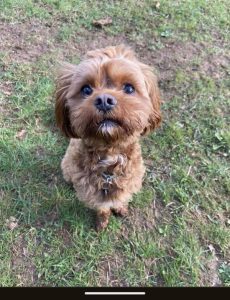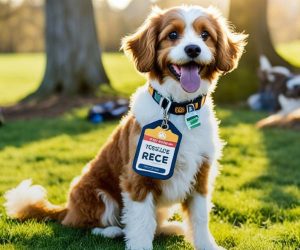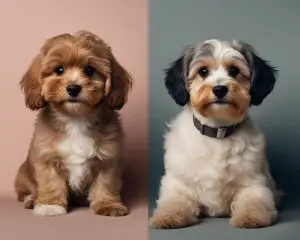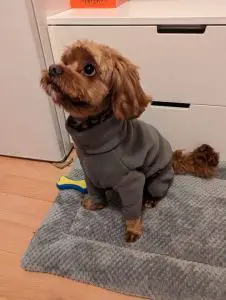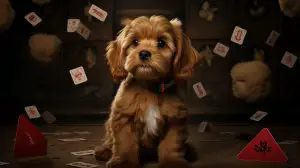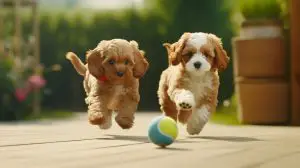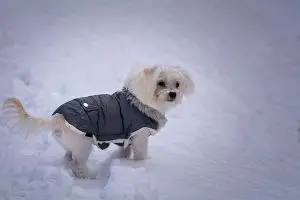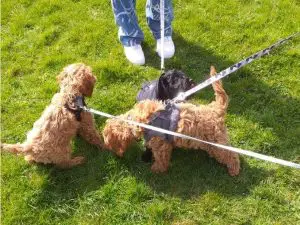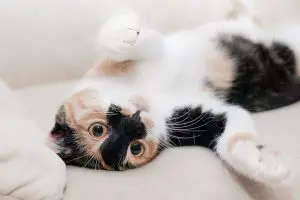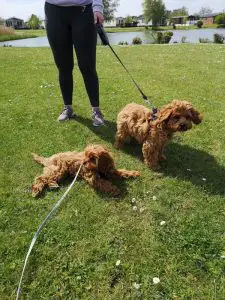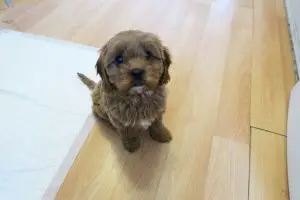It is common for Cavapoos to suffer from separation anxiety. This is because they are loving and affectionate dogs, they love being with their owners and are happy doing anything if their owner is nearby.
We’ll discuss separation anxiety in the rest of this piece and share tips on how to help your puppy and stop him suffering from it.

Why do Cavapoo get separation anxiety?
This warm clingy personality makes them more prone to separation anxiety.
If you’re the proud owner of an adorable Cavapoo, you’ll know how much they yearn to be with you. This makes them great pets but could give rise to a problem.
Without further ado, let’s dig into the detail.
Cavapoo puppy separation anxiety
Eight out of ten dogs suffer from separation anxiety, with Cavapoos being one of the breeds most prone to it because they tend to be clingy.
It occurs when a puppy is left alone somewhere – whether in the home or elsewhere – without its owner.
Signs of separation anxiety include:
- Exhibiting anxious behaviour when he spots that you’re about to leave.
- Acting up when you’ve left or showing signs of depression.
- Destroying, scratching, or chewing things when alone.
- Trying to escape.
- Howling or constant barking.
- Restless, fast pacing.
- Peeing and pooing in the house.
It is important to realise, however, that some dogs may not show physical manifestations of separation anxiety, even if they are suffering from it. It is therefore crucial to ensure that your Cavapoo is not distressed when left alone.
If your pup’s anxiety remains unchecked, it could develop into a disorder.
A good way to check if your pooch suffers separation anxiety if they show no outward signs of it is to compare their behaviour when you are with them to how they act when left alone. You could use a camera to help you do this.
The disorder is more prevalent in Cavapoos that have been adopted from shelters because they could have gone through multiple big changes in their lives which can mean they are predisposed to developing disorders.
Causes of separation anxiety
There are many potential reasons why a dog may suffer from separation anxiety, but they differ depending on a dog’s life experience and circumstance. Here are some of the most common causes and triggers for it.
- Moving to a new house.
- Separated from a previous owner.
- An absent family member who is usually around the dog often.
- An abrupt change in routine.
- They feel frightened or unsafe.
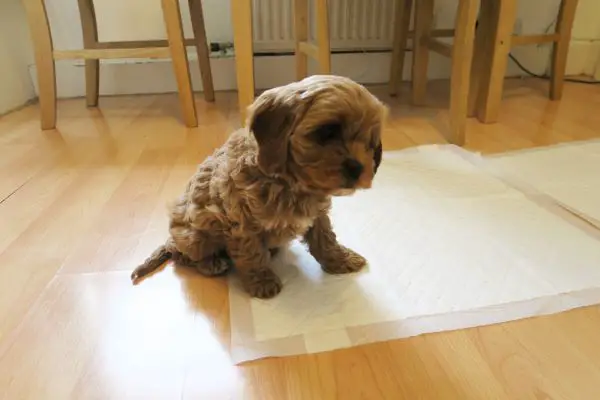
Do puppies grow out of separation anxiety?
Unfortunately, puppies do not just grow out of separation anxiety, and it might worsen if ignored. It can also happen at any age. Fortunately, there are some simple things you can do to help which are not difficult and just require a little love and attention.
It is worth noting that puppies are much less likely to suffer from separation anxiety if you begin good separation training at an early age. All breeds can be affected by it, with some breeds being more likely to suffer from it than others.
Now, let’s talk about how you can help your puppy.
How do I stop my puppy's separation anxiety?
It’s never fun to watch your beloved pup suffer. Luckily, there are ways to deal with and eventually stop separation anxiety so that they can better cope with loneliness.
Read my article on "How often should I let my dog out."
Crate training
If you think your pup has separation anxiety because he is scared or doesn’t feel secure, crate training may be the perfect solution.
Well trained dogs will come to see their crate as a haven. Distressed dogs need to know that they can get away from a situation, seek refuge in their crate and calm their anxiety.
Teach them to make positive associations with their crate by feeding them meals inside it and allow them to play with special tools when inside it. Read our post on leaving your dog downstairs at night to learn more about getting your dog used to being left alone through crate training.

Give them more exercise
Dogs love exercise. Check out this post if you’re curious about how much exercise a Cavapoo needs to be happy.
Tiring your pup out by giving them plenty of exercise and opportunities to play is a sure-fire way to combat separation anxiety.
A tired, content dog is likely to fuss than a pup that has lots of built-up energy to release.
Create background noise
You could try to stop your pup feeling alone by creating some background, perhaps by leaving the radio on.
Medication
Medication should only be used as a last resort and in consultation with a vet. If no other method is working, speak to your vet about appropriate medication for your pup.
Remember, separation anxiety is much easier to prevent than it is to stop. Therefore, you should give your pup the best home environment possible and start proper training as early as you can to prevent them from suffering from any sort of anxiety.
Make a point of leaving your dog alone for a little while, slowly increasing the length of time you leave them alone, so they gradually get used to you not being with them for a few hours. This will give your pup a confidence boost.
Take baby steps when you begin crate training your pup, until you reach your goal. Patience is key.
You should also read my post called "Can Cavapoo be left alone?"
Wrapping up
You’ll now be aware that any do may suffer from separation anxiety, know what signs to watch out for, and what you can do to prevent or moderate your pup’s distress.
With training and a healthy dose of patience, you can help your puppy conquer his fear of being left alone.
Just be consistent and leave him plenty of chew togs to keep him bust while you’re gone.
Read the latest Cavapoo posts here:
- Golden Cavapoo Guide: Care, Training & TipsAs a devoted dog lover, I can't help but feel a sense of joy and fulfillment whenever I see a wagging tail and a pair of eager eyes looking up at me. Dogs have this incredible ability to bring light, love, and companionship into our lives, and one particular breed that has stolen my heart… Read more: Golden Cavapoo Guide: Care, Training & Tips
- Adopt a Rescue Cavapoo Today – Find Your Buddy!Imagine coming home to a wagging tail, a warm snuggle buddy, and unconditional love. That's the joy of having a furry friend by your side. But what if I told you that you could not only experience the purest form of companionship but also change a life in the process? By adopting a rescue cavapoo,… Read more: Adopt a Rescue Cavapoo Today – Find Your Buddy!
- Black Cavapoo Puppies: Your Adorable GuideImagine coming home to a furry ball of excitement, wagging its tail and eagerly waiting for your return. Picture the joy of cuddling up on the sofa with a playful companion who brings laughter and warmth to your life. This is the magic that black Cavapoo puppies can bring to your world. Whether you're a… Read more: Black Cavapoo Puppies: Your Adorable Guide
- Straight Hair Cavapoo Traits and Care GuideHave you ever dreamed of having a furry companion who is not only adorable but also hypoallergenic? Someone who will bring joy and love into your life without triggering pesky allergies or leaving a trail of fur behind? Well, let me introduce you to the straight hair Cavapoo, the perfect blend of cuteness and allergy-friendly… Read more: Straight Hair Cavapoo Traits and Care Guide
- Best brush for a CavapooWhen you first bring your adorable little Cavapoo home, you’ll still be gathering all the things you need to take the best care of him or her. This post has been updated on 27th Feb 2024. One of the best brushes I’ve found is the Big G Slicker Brush by Chris Christensen. The longer pins… Read more: Best brush for a Cavapoo
- Meet the Unique Cavapoo with Blue Eyes - A Rare BeautyAs a professional journalist, I've had the pleasure of writing about various dog breeds, but the Cavapoo with blue eyes stands out as a true rarity. This captivating canine boasts striking blue eyes that add to its already unique charm. The Cavapoo breed with blue eyes is a sight to behold, with a playful personality… Read more: Meet the Unique Cavapoo with Blue Eyes - A Rare Beauty
- Comparing Breeds: Poochon vs Cavapoo - A Detailed InsightWhen it comes to selecting a new pet, many people find themselves deciding between the Poochon and Cavapoo breeds. While both are popular for their hypoallergenic qualities and suitability as family pets, there are distinct differences between the two that potential owners should consider. In this article, we will provide a detailed comparison of the… Read more: Comparing Breeds: Poochon vs Cavapoo - A Detailed Insight
- Adorable Newborn Cavapoo Puppies: A Must-Have CompanionGreetings! As a professional copywriting journalist, I am delighted to explore with you the irresistible charm of newborn Cavapoo puppies in this article. If you're a dog lover looking for a furry friend, you'll want to know how Cavapoo puppies make the perfect companions. Let's discover the joys of welcoming these adorable little bundles of… Read more: Adorable Newborn Cavapoo Puppies: A Must-Have Companion
- Meet the Adorable Ginger Cavapoo: Your Perfect CompanionIf you are in search of the ultimate companion that is both affectionate and adaptive, look no further than the ginger Cavapoo. These charming little dogs are a crossbreed between a Cavalier King Charles Spaniel and a Poodle, resulting in a lovable combination of traits that make them the perfect addition to any family. One… Read more: Meet the Adorable Ginger Cavapoo: Your Perfect Companion
- Your Guide to Adorable Ruby Cavapoo PuppiesWelcome to my comprehensive guide on ruby Cavapoo puppies! As a professional copywriting journalist, I have extensive experience researching and writing about different dog breeds. In this guide, we will explore everything you need to know about the adorable ruby Cavapoo, including their breed information, care tips, and why they make a perfect addition to… Read more: Your Guide to Adorable Ruby Cavapoo Puppies
- Overcoming Challenges: Why I Hate My Cavapoo & How To Love ItAs a Cavapoo owner, I know firsthand the challenges and frustrations that come with having this adorable breed as a furry companion. Despite their cute appearance and affectionate nature, Cavapoos can sometimes exhibit problem behaviors that lead to feelings of dislike and even resentment towards them. If you've ever found yourself saying "I hate my… Read more: Overcoming Challenges: Why I Hate My Cavapoo & How To Love It
- Unbiased Jonas Cavapoo Puppies Reviews: Happy Pet Parents Speak OutWhy Cavapoo Puppies are Highly Sought After As a professional copywriting journalist, I have had the opportunity to interact with many dog breeds. However, Cavapoos stand out as one of the most sought after breeds. But why? Cavapoo puppies are a perfect blend of the adorable, fun-loving, and affectionate attributes of a Cavalier King Charles… Read more: Unbiased Jonas Cavapoo Puppies Reviews: Happy Pet Parents Speak Out
- Explore Adorable River's Edge Cavapoos: Your Perfect Family PetAre you looking for a furry companion to bring joy and love into your family? If you're based in the US then you could take a look at River's Edge Cavapoos. Cavapoos are adorable puppies which are the perfect mix of Cavalier King Charles Spaniel and Poodle, resulting in a loving and gentle temperament that… Read more: Explore Adorable River's Edge Cavapoos: Your Perfect Family Pet
- Unveiling the Timeline: How Long for Cavapoo Hair to Grow BackAs a professional copywriting journalist, I often come across concerned Cavapoo owners wondering how long it will take for their pet's hair to regrow. The answer is not straightforward since several factors come into play in determining the time it takes for Cavapoo hair growth. In this section, I will explore the timeline for Cavapoo… Read more: Unveiling the Timeline: How Long for Cavapoo Hair to Grow Back
- Enjoy Comfort & Warmth with Equafleece Cavapoo Sweaters!As the temperature drops, it's essential to keep our furry friends warm and comfortable. The Equafleece Cavapoo Sweaters are a perfect solution to keep your Cavapoo cozy during the winter months. Equafleece is a renowned brand that offers high-quality dog fleece, including customized clothing for specific breeds, shapes and sizes, including our beloved Cavapoos. Equafleece… Read more: Enjoy Comfort & Warmth with Equafleece Cavapoo Sweaters!
- Understanding the Lifespan: How Long Will a Cavapoo Live?Welcome to our informative guide on the lifespan of a Cavapoo. As a loving pet owner, you want to ensure that your furry friend has the best possible quality of life. Knowing how long your Cavapoo is likely to live is an essential aspect of planning for their long-term care. In this section, we will… Read more: Understanding the Lifespan: How Long Will a Cavapoo Live?
- Essential Guide: What Should I Know Before Buying a Cavapoo?Are you considering bringing a Cavapoo into your home? These adorable pups are a popular mix of Cavalier King Charles Spaniel and Poodle, but before making a purchase, there are some essential things you should know. First and foremost, it's important to understand the care requirements, including grooming routines, nutrition needs, and exercise requirements. Additionally,… Read more: Essential Guide: What Should I Know Before Buying a Cavapoo?
- Is a Male or Female Cavapoo Better? Discover the Answer!Are you considering adding a Cavapoo to your family but unsure which gender to choose? Don't worry; you're not alone. Many potential pet owners find themselves asking the question, "Is a male or female Cavapoo better?" Fortunately, we're here to help you discover the answer. Before we dive into gender-specific characteristics, let's first understand the… Read more: Is a Male or Female Cavapoo Better? Discover the Answer!
- Can Cavapoo be Left Alone? Understanding Your Pet's Needs.As a Cavapoo owner, you may wonder whether your furry friend can handle alone time. Understanding your pet's needs is crucial to ensure their well-being and happiness. Cavapoos are known for their affectionate and loyal nature, which means they thrive on human companionship. However, they're also adaptable and can adjust to periods of alone time… Read more: Can Cavapoo be Left Alone? Understanding Your Pet's Needs.
- Does a Cavapoo Smell? Decoding Your Pup's Unique ScentAs a Cavapoo owner, you know that these adorable pups are a joy to be around. However, you may have noticed a unique scent emanating from your furry friend. But does a Cavapoo smell? The answer is yes, just like any other dog breed, Cavapoos have an odour. But don't worry, there are ways to… Read more: Does a Cavapoo Smell? Decoding Your Pup's Unique Scent
- Addressing Cavapoos Problems: What You Should KnowWelcome to our guide on Cavapoos! These adorable furry companions are known for their friendly and loving nature, but just like any other breed, they may encounter certain problems. In this section, we will discuss the common problems faced by Cavapoos, including their health issues and other challenges. It is important for prospective and current… Read more: Addressing Cavapoos Problems: What You Should Know
- Decoding the Price: How Much Should a Cavapoo Cost?Are you considering adding a Cavapoo to your family but unsure about the cost? We understand that the pricing of Cavapoos can vary greatly, making it challenging to determine what you should be paying. In this article, we'll explore the various factors that affect the cost of a Cavapoo, including health checks, pedigree, and breeder… Read more: Decoding the Price: How Much Should a Cavapoo Cost?
- Cavapoo vs Cockapoo: What's Better? Explore Your Pup Choice!Choosing a furry friend to join your family can be a challenging decision, especially when it comes to the popular Cavapoo and Cockapoo breeds. Both are a combination of two adorable purebreds, making them highly sought after for their charming looks and loving personalities. If you're wondering "what's better Cavapoo or cockapoo," you're not alone.… Read more: Cavapoo vs Cockapoo: What's Better? Explore Your Pup Choice!
- Uncovering the Truth: Are Cavapoos Good Temperament Dogs?Welcome to our guide on Cavapoo temperament! If you're considering getting a Cavapoo, or just curious about their temperament, you've come to the right place. In this article, we'll explore the personality and behaviour of this adorable breed. Many people wonder, "Are Cavapoos good temperament dogs?" The answer is a resounding yes! Cavapoos are known… Read more: Uncovering the Truth: Are Cavapoos Good Temperament Dogs?
- Do Cavapoos Bark a Lot? Your Guide to Understanding Cavapoo BehaviorAre you considering getting a Cavapoo or already own one? One of the most common questions asked about these adorable pups is: do Cavapoos bark a lot? Cavapoos can be moderately vocal, their tendency to bark depends on their individual personality. Early training will certainly help manage excessive barking. As with any dog breed, Cavapoos… Read more: Do Cavapoos Bark a Lot? Your Guide to Understanding Cavapoo Behavior
- Unveiling the Truth: Do Cavapoos Make Good Pets?Yes, Cavapoos make good pets. They're known for their friendly and sociable nature. They are a crossbreed of Cavalier King Charles Spaniel and Poodle, combining the affectionate nature of the former with the intelligence of the latter. Obviously my opinion may well be biased as I absolutely love my Cavapoo, he's called Bean. That said… Read more: Unveiling the Truth: Do Cavapoos Make Good Pets?
- Merle CavapooDiscover the enchanting Merle Cavapoo, a delightful crossbreed with a splash of colour. Unleash joy and beauty with this charming companion. Find out more now! Key Takeaways: Merle Cavapoo Introduction The Merle Cavapoo is a highly sought-after breed that combines the intelligence of the Poodle with the affectionate nature of the Cavalier King Charles Spaniel.… Read more: Merle Cavapoo
- Cavapoo UnderbiteExplore the causes and solutions for underbites in Cavapoos. Learn how to care for your pet's dental health and ensure their long-term wellbeing. The posh word for "Underbite" is "Malocclusion" but I always try to use simple plain language in my blog posts whenever possible. If you read through this I'm confident you'll have a… Read more: Cavapoo Underbite
- Does my Cavapoo need a winter coat?Cavapoos can feel the cold. You might want to think about buying him/her a coat to keep warm and provide a little extra protection against the weather. Several coats are water/windproof and cover most of the body, to trap in heat and keep them warm. Unsure what coat to go for, or whether your dog… Read more: Does my Cavapoo need a winter coat?
- Are Cavapoos Good with Kids?Cavapoos are great with kids. Cavapoos live to have fun, making them perfect playmates for kids, especially those 6 years and over. They enjoy getting involved in dog sports and activities and are great at playing fetch and chasing balls. They love spending time with people and are unfailingly loyal. In the rest of this… Read more: Are Cavapoos Good with Kids?
- Do Cavapoos Get on Well with Cats?Yes, they do. Cavapoos adore the company of other animals — even cats! Their playful nature makes them great companions for your feline friends. Cavapoos are happy go lucky and will be happy to play for as long as your cat permits. You should supervise them the first time they are together though. You can… Read more: Do Cavapoos Get on Well with Cats?
- Are Cavapoos Prone to Separation Anxiety?It is common for Cavapoos to suffer from separation anxiety. This is because they are loving and affectionate dogs, they love being with their owners and are happy doing anything if their owner is nearby. We’ll discuss separation anxiety in the rest of this piece and share tips on how to help your puppy and… Read more: Are Cavapoos Prone to Separation Anxiety?
- How much exercise does a Cavapoo need?Cavapoos are gorgeous little high-energy dogs that are becoming ever more popular thanks to their lively dispositions, sociability, and great temperaments. You’ll want to make sure your furry friend gets lots of stimulation and exercise so that they don’t become cute little energy-filled home wreckers. A fully-grown, healthy Cavapoo needs a minimum of 40 minutes… Read more: How much exercise does a Cavapoo need?
- Are Cavapoos easy to potty train?When you first pick up your new Cavapoo puppy it’s an absolute delight, and the fun and love they’ll give you is immense. However, if they’re not house trained in a timely manner it can start to be a problem. Potty training a Cavapoo puppy can be challenging, but because they are one of the… Read more: Are Cavapoos easy to potty train?

